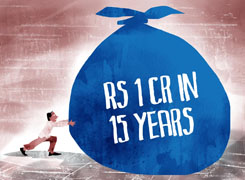Ramalingam Kalirajan |10874 Answers |Ask -Follow
Mutual Funds, Financial Planning Expert - Answered on Jul 11, 2024
He has an MBA in finance from the University of Madras and is a certified financial planner.
He is the director and chief financial planner at Holistic Investment, a Chennai-based firm that offers financial planning and wealth management advice.... more

Hello ,I have got into addmission in nit durgapur in mtech. My financial condition is not to strong so I have decided to take a loan in 8.5% interest rate .I am going to get 12,400/- and my loan is 3 times 83100 /- (food and stay covered ) in 6 month gap.if I am going to pay the installment within my study period I got 1% concession. What to do with the money I got monthly.investing in sip/Rd/paying interest or loan
Understanding Your Financial Situation
You have decided to take a loan at an 8.5% interest rate. The loan amount is Rs. 83,100, with installments spread over six months. Your monthly stipend is Rs. 12,400, which needs to cover your expenses and possibly save or invest wisely. Let's analyze your options in detail.
Option 1: Systematic Investment Plan (SIP)
Investing in a Systematic Investment Plan (SIP) can be a smart choice. SIPs allow you to invest a fixed amount regularly in mutual funds. This method helps in averaging the purchase cost and compounding returns over time.
Advantages of SIP:
Disciplined Investment: SIPs instill a disciplined approach to investing. You commit to investing regularly, which helps in building a substantial corpus over time.
Rupee Cost Averaging: By investing regularly, you buy more units when prices are low and fewer units when prices are high. This averaging effect can reduce the impact of market volatility.
Power of Compounding: The longer you stay invested, the more you benefit from compounding returns. Even small amounts can grow significantly over time.
Risk Assessment:
Market Risk: Mutual funds are subject to market risks. The value of your investments can fluctuate based on market conditions. However, investing for the long term can mitigate these risks.
Option 2: Recurring Deposit (RD)
A Recurring Deposit (RD) is a safe and secure investment option offered by banks. It allows you to deposit a fixed amount regularly and earn interest on it.
Advantages of RD:
Safety: RDs are considered low-risk investments. Your principal amount is secure, and you earn a fixed interest rate.
Regular Savings: Like SIPs, RDs encourage regular savings. You commit to depositing a fixed amount each month, which helps in accumulating a significant sum over time.
Risk Assessment:
Lower Returns: RDs offer lower returns compared to mutual funds. The interest rates are fixed and may not keep pace with inflation.
Liquidity: RDs have a fixed tenure, and premature withdrawal may result in penalties. This can affect your liquidity in case of emergencies.
Option 3: Paying Off Loan Interest
Paying off the loan interest regularly can be a prudent choice. Since you get a 1% concession if you pay the installment within your study period, this option can save you money in the long run.
Advantages of Paying Off Loan Interest:
Reduced Interest Burden: Paying off the interest regularly can reduce the overall interest burden. This can help you save money over the loan tenure.
Credit Score: Timely repayment of loans can positively impact your credit score. A good credit score is essential for future financial needs.
Risk Assessment:
Opportunity Cost: By paying off the loan interest, you might miss out on potential returns from investments. However, the certainty of reduced interest payments can be a strong motivator.
Evaluating Your Options
Let's evaluate each option in the context of your financial situation and goals.
Investing in SIP:
Pros: Potential for higher returns, disciplined investment approach, benefits of rupee cost averaging, and compounding.
Cons: Subject to market risks, requires a long-term investment horizon.
Investing in RD:
Pros: Safe and secure investment, regular savings, fixed returns.
Cons: Lower returns compared to mutual funds, potential penalties for premature withdrawal.
Paying Off Loan Interest:
Pros: Reduced interest burden, potential savings, positive impact on credit score.
Cons: Missed opportunity for potential higher returns from investments.
Recommended Strategy
Considering your situation, a balanced approach might be the most effective. Here's a recommended strategy:
Emergency Fund: First, set aside a portion of your stipend for an emergency fund. This fund should cover at least three to six months of your expenses. It provides a safety net in case of unexpected financial needs.
Pay Off Loan Interest: Given the 1% concession on timely payments, prioritize paying off your loan interest. This will reduce your overall interest burden and help you save money in the long run.
Invest in SIP: Allocate a portion of your stipend to a SIP in mutual funds. This will help you build a corpus over time and take advantage of compounding returns. Choose funds based on your risk tolerance and investment horizon.
Recurring Deposit: If you prefer a safer investment option, consider opening an RD with a smaller portion of your stipend. This will provide fixed returns and ensure regular savings.
Power of Compounding
Investing in SIPs can harness the power of compounding. Even small amounts, when invested regularly, can grow significantly over time. For example, investing Rs. 3,000 per month in a mutual fund with an average annual return of 12% can grow substantially over 10 years. The power of compounding can help you achieve your financial goals.
Mutual Funds: Categories and Advantages
Mutual funds come in various categories, each with its advantages and risk profiles. Here's a brief overview:
Equity Funds: Invest in stocks, offering higher returns with higher risk. Suitable for long-term goals.
Debt Funds: Invest in fixed-income securities, offering stable returns with lower risk. Suitable for short to medium-term goals.
Hybrid Funds: Invest in a mix of equity and debt, offering balanced returns with moderate risk. Suitable for medium-term goals.
Final Insights
Balancing your financial goals with current needs is key to effective planning. By setting aside an emergency fund, paying off loan interest, and investing in SIPs and RDs, you can create a robust financial plan. Remember, the power of compounding and disciplined investments can significantly enhance your financial stability.
Best Regards,
K. Ramalingam, MBA, CFP,
Chief Financial Planner,
www.holisticinvestment.in
You may like to see similar questions and answers below
Ramalingam Kalirajan |10874 Answers |Ask -Follow
Mutual Funds, Financial Planning Expert - Answered on May 09, 2024
Ramalingam Kalirajan |10874 Answers |Ask -Follow
Mutual Funds, Financial Planning Expert - Answered on Jul 10, 2024
Ramalingam Kalirajan |10874 Answers |Ask -Follow
Mutual Funds, Financial Planning Expert - Answered on Jul 01, 2024
Ramalingam Kalirajan |10874 Answers |Ask -Follow
Mutual Funds, Financial Planning Expert - Answered on Jun 03, 2025
Ramalingam Kalirajan |10874 Answers |Ask -Follow
Mutual Funds, Financial Planning Expert - Answered on Aug 11, 2025
Mayank Chandel |2569 Answers |Ask -Follow
IIT-JEE, NEET-UG, SAT, CLAT, CA, CS Exam Expert - Answered on Dec 08, 2025
Mayank Chandel |2569 Answers |Ask -Follow
IIT-JEE, NEET-UG, SAT, CLAT, CA, CS Exam Expert - Answered on Dec 08, 2025

Mayank Chandel |2569 Answers |Ask -Follow
IIT-JEE, NEET-UG, SAT, CLAT, CA, CS Exam Expert - Answered on Dec 08, 2025
Mayank Chandel |2569 Answers |Ask -Follow
IIT-JEE, NEET-UG, SAT, CLAT, CA, CS Exam Expert - Answered on Dec 08, 2025
Mayank Chandel |2569 Answers |Ask -Follow
IIT-JEE, NEET-UG, SAT, CLAT, CA, CS Exam Expert - Answered on Dec 08, 2025
Anu Krishna |1746 Answers |Ask -Follow
Relationships Expert, Mind Coach - Answered on Dec 08, 2025
Ramalingam Kalirajan |10874 Answers |Ask -Follow
Mutual Funds, Financial Planning Expert - Answered on Dec 08, 2025
Samraat Jadhav |2499 Answers |Ask -Follow
Stock Market Expert - Answered on Dec 08, 2025
Ramalingam Kalirajan |10874 Answers |Ask -Follow
Mutual Funds, Financial Planning Expert - Answered on Dec 08, 2025
Radheshyam Zanwar |6737 Answers |Ask -Follow
MHT-CET, IIT-JEE, NEET-UG Expert - Answered on Dec 08, 2025

























